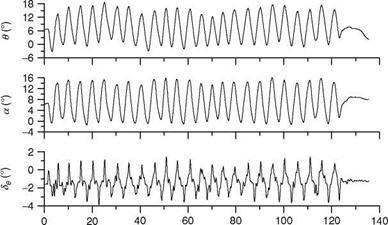SPECIFIC DYNAMIC MANEUVERS FOR DETERMINATION OF DRAG POLARS
In order to determine lift/drag performance of an aircraft from flight data, one can plan to conduct dynamic maneuvers [12,13]. These maneuvers place lesser restrictions on the pitching motion of an aircraft while conducting the maneuver.
|
|
|
Time (s) FIGURE 7.8 LAM flight-time histories. |
The classical steady-state maneuver is used for drag polar determination using static weight/lift and drag/thrust balance equation:
W = L = дЗСь^т; D = qSCDam; T – D – Wsing = 0
coefficients at the trim AOA. Measurement of the dynamic pressure is also important. The aircraft is thus trimmed at required AOA. The total time consumed for these experiments would be much more than that taken by dynamic maneuvers. Dynamic maneuvers cover a large range of AOA, Mach number, and normal accelerations and still take flight test time of about one fourth of the static/steady-state maneuvers, saving time, effort, and fuel for the flight tests. However, it is required to carry out flight data analysis, and using parameter estimation methods, the drag and lift coefficients are estimated. Then drag coefficients are plotted versus lift coefficients to obtain the drag polars.













